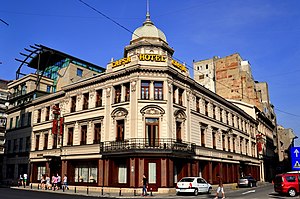Casa Capşa
Casa Capşa is a historic restaurant in Bucharest, Romania, first established in 1852. During several periods of its existence it has also included a hotel; most recently, it reopened as a 61-room hotel on 17 June 2003.[1] "…long a symbol of Bucharest for its inhabitants… Capsa is not only associated with its exquisite pastry products, but also for a hectic literary life of yore… a welcoming place for Romanian writers where they could meet, talk and…associate." [2]
The restaurant stands on Calea Victoriei at the corner of Edgar Quinet Street, across from the Hotel Capitol and diagonally across from the Cercul Militar.
The restaurant, confectionery, and coffee house
In 1852, Anton and Vasile Capşa founded the first confectionery shop on Calea Victoriei, somewhat north of the present Casa Capşa, which was founded by their younger brother Grigore Capşa (1841-1902) in 1868. [2][1] Anton and Vasile had financed Grigore through four years of courses at the renowned Boissier Paris, where he turned down an opportunity to become the supplier for the French Imperial Court. [3] The French-inspired confectionery of Casa Capşa soon established a continent-wide reputation. The business expanded in 1881 to a full-service restaurant, at a time when quality restaurants along Western European lines were still quite a rarity in Romania.[2][1]
Casa Capşa invented the all-chocolate Joffre cake in honor of a visit to Romania by Joseph Jacques Césaire Joffre after World War I, and they were the first to introduce ice cream to Romania.[2]
The coffee house, established 1891, was an important literary and artistic gathering place, but never turned a profit, "because the writers and artists who went there usually ordered mineral water and coffee and made them last for hours on end."[3] In contrast to the elegant restaurant and confectioner, the coffee house had simple, uncovered wooden tables. Tudor Arghezi referred to it as an "Academy"; one could make a literary reputation by reading one's texts there.[3] Actors also were among the regulars: at the time the Romanian National Theatre was nearly across the street, adjacent to the Terasa Oteteleşanu, now the site of the Palatul Telefoanelor.[4]
When the Romanian Communist Party took power in 1948, they closed Casa Capşa. The restaurant operated during most of the communist era as the "Bucharest Restaurant", regaining the Capşa name in 1984.[3]
The In Your Pocket guide series describes it as having been "…the chosen venue for the beautiful people at the turn of the [19th] century… it degenerated into a Communist party haunt for the illiterate and intellectually unendowed party bosses." [5] Mioara Ioniţă writes, "Its fame remains, but it has lost some of its pre-war glamour. It exists as such, but the spirit that animated it has vanished."[3]
The hotel
The enterprise was expanded in 1886 to include the Capşa Hotel, initially a guest house for members of parliament from out of town.[2] The French manager had formerly managed the Hôtel Café Anglais in Paris. In 1908, the British magazine John Bull ranked it "among the best hotels in the world". According to the revived hotel's web site, "It was considered for a long time the only suitable residence of the artists, rich and aristocratic families or high rank politiciens [sic] and diplomats visiting Romania,"[1] a role it would eventually yield to the Athénée Palace.
Among the hotel's guests in its heyday were German Kaisers Wilhelm I and Wilhelm II; Austro-Hungarian emperor Franz Josef I; several members of the Imperial Russian royal family, including Tsar Alexander II; all four Romanian monarchs and their queens consort; kings of Greece, Serbia, and Bulgaria; and such other notables as Josephine Baker, Sarah Bernhardt, Enrico Caruso, George Enescu, Averell Harriman, Joseph Pilsudski, and Raymond Poincaré.[1]
Notes
- ↑ 1.0 1.1 1.2 1.3 1.4 Capsa Hotel History on Casa Capşa's official site. Accessed 17 March 2006.
- ↑ 2.0 2.1 2.2 2.3 2.4 The Capsa Coffee House on Radio Romania International. Last ellipsis ("and…associate") in original. Accessed 17 March 2006.
- ↑ 3.0 3.1 3.2 3.3 3.4 Mioara Ioniţă, cited at The Capsa Coffee House on Radio Romania International. Accessed 17 March 2006.
- ↑ List of Names and Places Explained: The Telephone Palace, in Bucharest Between the Wars: A Modernity With Fringes, Romanian Academy Library, accessed 4 January 2006.
- ↑ Casa Capşa on InYourPocket.com. Accessed 17 March 2006.
